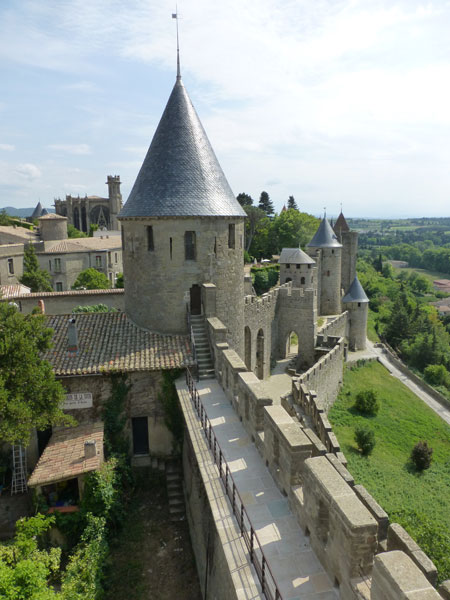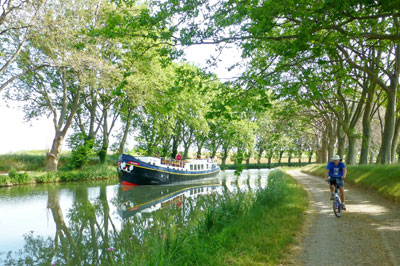Barging the Canal du Midi
This item appears on page 55 of the September 2015 issue.
(Second of two parts)
One of the attractions of barge cruising along the Canal du Midi in France is the opportunity to bike on the towpaths that line its entire 150-mile length. On a partially hosted cruise with European Waterways aboard the classic, Dutch-designed barge Anjodi in June 2015, my wife, Gail, and I took advantage of the biking options along our route from Le Somail to Marseillan.
The Anjodi carries a bicycle for each passenger, and we found their new folding bikes quite adequate for our daily rides. The terrain was essentially flat, so biking was not difficult in most areas, and at times we could pedal away from the canal and explore. On the leg from Pigasse to Capestang, we cycled well ahead of the barge, giving us time to wander through the village on our own.
The final morning of our cruise, we were moored close to the sea, only 15 minutes away by bike, so at 6:45 I rode to the Marseillan beach for a most refreshing swim. Wet and happy, I then scored a perfect cappuccino at a just-awakening beach boulangerie before heading back to the boat, arriving just as the others were beginning to stir. That solo morning escape was pure magic.
Carcassonne and Narbonne
A comfortable minivan carried us on excellent daily excursions led by our tour guide, Jeff.
On the second day of the cruise, we enjoyed a guided walking tour of the walled city of Carcassonne. First constructed in the Gallo-Roman era and completely rebuilt around 1844, it is a magnificent example of a medieval fortified city. From the base of the hill below the walls, the ancient city seemed to reach into the clouds.
The next day, with the barge moored in the idyllic village of Capestang, we journeyed to the tiny village of Minervois to explore the 12th-century Cathar fortress perched atop a deep limestone gorge.
On day four we did a walking tour of a most appealing city, Narbonne. Located on the Via Domitia, the ancient Roman road along the coast, Narbonne was a major port in the first century BC. In its restored medieval quarter, we were amazed by the huge, Gothic-style Cathedral of Saint-Just, including cloisters with four awe-inspiring vaulted galleries, and by the adjacent Palais des Archevêques.
We also visited the expansive indoor market, featuring wine, coffee, cheese and olive bars plus crafts, produce and an amazing array of seafood.
After our trip, Narbonne — set among a vast sweep of vineyards — replaced Montpellier as the transfer location before and after the cruise. I recommend spending an extra night or two there.
We continued to the outskirts of Béziers via the Malpas Tunnel, Europe’s oldest navigational canal tunnel, mooring at Fonserannes at the top of the flight of seven locks we would tackle the following morning.
From locks to lagoon
After our fascinating morning traversing of the staircase lock system, we crossed the Orb River on a canal viaduct, enjoying elevated views of the city of Béziers. Later we docked in a rural setting near Portiragnes, where the canal is closest to the Mediterranean.
In mid-afternoon we traveled to 14th-century Château de Perdiguier, known for its frescoes and more recently for both the red and white wines produced at their small vineyards. Our tour of the château and winery, while most informative, seemed to carry on and on in the very warm afternoon, mercifully culminating in a refreshing tasting session in the cellar.
Returning to the Anjodi, we were greeted by a talented jazz trio comprising retired expats, a most pleasant surprise.
On our final cruising day, we emerged from the du Midi into the saltwater lake of Thau, docking in the fishing village of Marseillan. By minivan, we undertook an excursion to Pézenas, the well-preserved, idyllic, 14th-century capital of the Languedoc region. Following a tour with guide Jeff, we roamed the narrow lanes on our own, a final chance for shopping.
The setting of the captain’s farewell dinner on the deck of the Anjodi was under a magnificent night sky overlooking the expanse of the Thau lagoon — a fitting climax to our journey through time on the Canal du Midi.
Getting to southwestern France
Gail and I were committed to using award miles for our air travel to France. Even though we are in the United MileagePlus and American Airlines AAdvantage programs, we always try to utilize those miles to fly on their partner carriers, seeking a flight experience generally a grade or two above those typically provided by the big three American carriers.
Using our MileagePlus account, we were, to my surprise, able to secure flights relatively easily with United alliance partner carrier Lufthansa from Boston to our destination, Toulouse, in southwestern France. This included close-to-perfect connections through Frankfurt outbound and Munich on return.
We were happy with the Lufthansa economy-class experience, including excellent food provided per our Asian vegetarian special-meal requests.
Incidentally, on flights within the European Union, I advise not traveling with a carry-on 21 inches long or larger, although enforcement can vary from flight to flight.
Upon arriving in Toulouse from Frankfurt, we took the airport shuttle ($17 per person) to the TGV station, a 20-minute ride, and purchased tickets ($42 each) for the 2-hour high-speed rail journey to Montpellier, where we would be picked up for our barge cruise two days later.
Summing up
In preparation for this trip, we converted both our Visa and MasterCard credit cards to new chip-and-signature cards that, thankfully, worked for all applications attempted in France and Spain, including restaurant meals, train tickets and motorway toll booths.
In all uses except for motorway toll booths (where no signatures were required), we signed when using the cards. (PINs, offering an extra level of security, are required with European-style chip-and-PIN credit cards.)
At ATMs we used our Bank of America ATM card at B of A affiliate banks — BNP Paribas in France and Deutsche Bank in Spain and Germany.
European Waterways offers cruises in many areas of Europe. The Canal du Midi is the farthest south of these and, therefore, enjoys the longest fair-weather barging season. There is no need to do the du Midi cruise in the peak summer months, when it can be quite hot. I would consider the ideal du Midi cruising time to be April/May and September/October.
Keep in mind that this cruise operates in both directions. I particularly enjoyed being able to finish our cruise on the coastal strip at Marseillan.
European Waterways’ website provides a full range of barge cruises in nine countries throughout Europe, including the UK and Ireland. Currently, about half of their forward bookings are charters, with multigenerational and other family groups being the most popular category. Most of the barges accommodate eight passengers, but four accommodate 12 and one, up to 20.
Contact European Waterways (based in the UK; call, toll-free in the US, 877/879-8808 or, in Canada, 877/574-3404, www.gobarging.com).
Contact Randy at 80 America Way, Jamestown, RI 02835; 401/560-0350, randykeck@yahoo.com.


